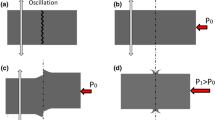Abstract
In order to investigate the complicated thermomechanically coupled process of linear friction welding (LFW), three different numerical methods were developed using the ABAQUS software. LFW steel and Ti-6Al-4V were calculated by using a 2D model with the explicit and implicit methods, respectively, and the calculated results were validated by experiments. In addition, a 3D model for LFW Ti-5Al-2Sn-2Zr-4Mo-4Cr was firstly acquired by using the newly developed explicit-implicit alternate method and the calculated flash seemed more like the real one. Furthermore, a few open questions and perspectives in LFW modeling are discussed and concluded.









Similar content being viewed by others
References
A. Vairis and M. Frost, On the Extrusion Stage of Linear Friction Welding of Ti 6Al 4V, Mater. Sci. Eng., A, 1999, 271, p 477–484
A. Vairis and M. Frost, Modeling the Linear Friction Welding of Titanium Blocks, Mater. Sci. Eng., A, 2000, 292, p 8–17
J. Tao, T.C. Zhang, P.T. Liu, and J. Li, Numerical Computation of a Linear Friction Welding Process, Mater. Sci. Forum, 2008, 575–578, p 811–815
E. Ceretti, L. Fratini, C. Giardini, and D. La Spisa, Numerical Modeling of the Linear Friction Welding Process, Int. J. Mater. Form., 2010, 3, p 1015–1018
W.Y. Li, T.J. Ma, and J.L. Li, Numerical Simulation of Linear Friction Welding of Titanium Alloy: Effects of Processing Parameters, Mater. Des., 2010, 31, p 1497–1507
J. Sorina-Müller, M. Rettenmayr, D. Schneefeld, O. Roder, and W. Fried, FEM Simulation of the Linear Friction Welding of Titanium Alloys, Comp. Mater. Sci., 2010, 48, p 749–758
R. Turner, J.C. Gebelin, R.M. Ward, and R.C. Reed, Linear Friction Welding of Ti-6Al-4V: Modelling and Validation, Acta Mater., 2011, 59, p 3792–3803
M. Grujicic, G. Arakere, B. Pandurangan, C.F. Yen, and B.A. Cheeseman, Process Modeling of Ti-6Al-4V Linear Friction Welding (LFW), J. Mater. Eng. Perform., 2011, 21, p 2011–2013
W.Y. Li, T.J. Ma, S.Q. Yang, Z.Q. Xu, Y. Zhang, J.L. LI, and H.L. Liao, Effect of Friction Time on Flash Shape and Axial Shortening of Linear Friction Welded 45 Steel, Mater. Lett., 2007, 62, p 293–296
M. Maalekian, E. Kozeschnik, H.P. Brantner, and H. Cerjak, Comparative Analysis of Heat Generation in Friction Welding of Steel Bars, Acta Mater., 2008, 56, p 2843–2855
G. Pintaude, D.K. Tanaka, and A. Sinatora, The Effects of Abrasive Particle Size on the Sliding Friction Coefficient of Steel Using a Spiral Pin-on-Disk Apparatus, Wear, 2003, 255, p 55–59
ABAQUS Analysis User’s Manual, ABAQUS Version 6.8 HTML Documentation, Dassault Systèmes, 2008
B. Lang, T.C. Zhang, X.H. Li, and D.L. Guo, Microstructural Evolution of a TC11 Titanium Alloy During Linear Friction Welding, J. Mater. Sci., 2010, 45, p 6218–6224
Acknowledgments
The authors would like to thank for financial support the National Natural Science Foundation of China (51005180), the Program for New Century Excellent Talents in University by the Ministry of Education of China (NECT-08-0463), the Fok Ying-Tong Education Foundation for Young Teachers in the Higher Education Institutions of China (131052), the Fundamental Research Fund of NPU (JC201233), and the 111 Project (B08040).
Author information
Authors and Affiliations
Corresponding author
Rights and permissions
About this article
Cite this article
Li, W., Wang, F., Shi, S. et al. Numerical Simulation of Linear Friction Welding Based on ABAQUS Environment: Challenges and Perspectives. J. of Materi Eng and Perform 23, 384–390 (2014). https://doi.org/10.1007/s11665-013-0776-8
Received:
Revised:
Published:
Issue Date:
DOI: https://doi.org/10.1007/s11665-013-0776-8




